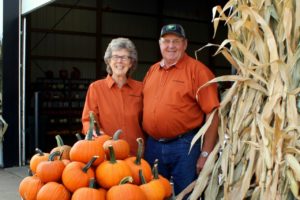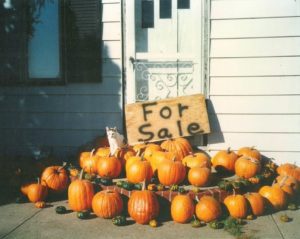
Helen Huitink and her late husband, Dave, are affectionally known to the Orange City community as “Grandma and Grandpa Pumpkin.” Photo courtesy of Pumpkinland.
By Lauren Moore, Public Affairs Specialist
Twenty-nine years ago, Helen Huitink and her late husband, Dave, started Pumpkinland, an annual event on their farm in Orange City, Iowa, where people can purchase autumn produce, take a turn through corn mazes, and visit farm animals. Known affectionately as “Grandma and Grandpa Pumpkin,” their farm has become a fall tradition for many in their community.
The 160-acre farm has been in the Huitink family since 1911.
“We have always grown corn and soybeans,” Helen said. “Back in the earlier days, we grew some alfalfa and oats. We also milked cows here for many years and raised hogs.”
An Unexpected Venture
While corn and soybeans still are grown on the farm, the Huitinks grow more than 100 varieties of pumpkins, gourds and squash each year.
“Our pumpkin business actually started by accident,” Helen said. “My husband had often grown pumpkins in the garden when the kids were growing up. In 1988, he set up a corn shock with pumpkins around it by the edge of the garden. Someone stopped to ask if we had pumpkins for sale.”
In 1989, their three children, Sherry, Kelly and Darren, grew pumpkins and sold them off their front step. Moving off the front step and into the garage, they grew and sold more pumpkins year after year. Realizing they needed more space, they built a warehouse in 1996.
“That’s when we really intentionally began to grow the business. We put up our warehouse, where we sell out of today, and took on crafters and bakers,” said Helen. “We sold corn and soybean seed in the spring and pumpkins in the fall. It worked out very well.”

In the early years of the business, the Huitinks sold pumpkins off their front step and in their garage. Photo courtesy of Pumpkinland.
The Farm Experience
During the fall, the Huitinks host school field trips to teach children how pumpkins are grown.
“Many kids don’t get a chance to ever go on a farm,” Helen said. “They have no idea what some of the farm animals look like or how crops grow. We want to give them the farm experience.”
While Pumpkinland is only operational for two months in the fall, planning for it is a year-round effort – picking out seed in the winter, planting in the spring, and weeding in the summer.
“It’s basically a year-round project for me,” Helen said. “In the winter time we are dreaming and scheming, coming up with new ideas.”
The Orange Fleet
Just as she loves to watch her crops grow, Helen’s favorite part about fall is seeing families return to Pumpkinland year after year.
For almost three decades, pumpkins have been an integral part of the Huitinks’ lives. Helen can even be seen driving around town in an orange PT Cruiser.
“My husband searched for that car for quite a few years and finally found it,” she said. “He called it our date car. Since then, we purchased an orange pickup and an orange van, so we have three orange vehicles. We called it our orange fleet. After purchasing the third car, Dave made the comment that we might have just gone off the deep end.”

The Huitinks work year-round to give visitors the farm experience every fall. Photo courtesy of Pumpkinland.
Working with USDA
To protect against market shortfalls and provide a crucial safety-net, the Huitinks enrolled their corn and soybeans in the Agriculture Risk Coverage and Price Loss Coverage programs.
With the Conservation Reserve Program, Dave and Helen added filter strips alongside a creek that runs through the property to prevent erosion. For a yearly rental payment, producers enrolled in the program remove environmentally sensitive land from agricultural production and plant vegetation that will improve environmental health and quality.
These programs are administered through USDA’s Farm Service Agency. For more information about USDA programs and to find your local service center, visit farmers.gov.






2 Responses to Cultivating Pumpkins and Fall-Time Traditions